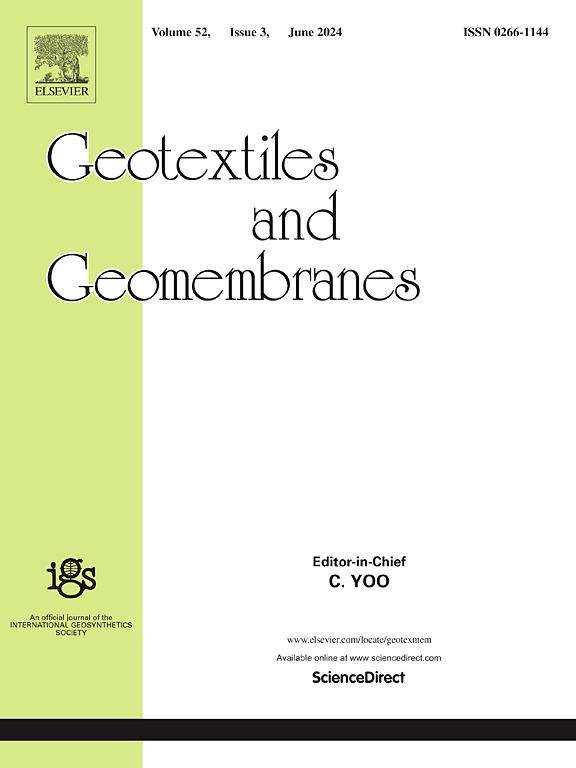Mechanical properties and mechanisms of soil-geotextile interface under constant normal Stiffness: Effect of freezing conditions
IF 6.2
1区 工程技术
Q1 ENGINEERING, GEOLOGICAL
引用次数: 0
Abstract
A set of direct shear tests on the soil-geotextile interface (SGI) were conducted using a temperature-controlled constant normal stiffness (CNS) direct shear apparatus. This was done in order to evaluate the effects of normal stiffness, initial normal stress, soil water content, and temperature on SGI shear behavior and micro-deformation patterns. The observations indicate that all shear stress-shear displacement curves demonstrate strain-hardening characteristics, with SGI cohesion and friction angle increasing at higher normal stiffness and lower temperatures. At freezing conditions, water content significantly affects the interface friction angle, while this effect is minimal at positive temperatures. Normal stress increases with higher water content, lower temperatures, and higher normal stiffness. Shear stress initially rises with normal stress before decreases, with a more pronounced rise under sub-zero conditions. Normal stress shrinkage shows a positive correlation with normal stiffness. Micro-deformation analysis of soil particles at the interface indicates significant strain localization within the shear band, which is less pronounced under sub-zero temperatures compared to positive temperatures. These patterns of normal displacement vary across analysis points within the shear band, with the macroscopic normal displacement reflecting a cumulative effect of these microscopic variations.
恒法向刚度条件下土-土工织物界面力学特性及机理:冻结条件的影响
采用温控恒法向刚度(CNS)直剪仪对土工织物界面(SGI)进行了直剪试验。这样做是为了评估法向刚度、初始法向应力、土壤含水量和温度对SGI剪切行为和微变形模式的影响。结果表明:在较高的法向刚度和较低的温度下,剪切应力-剪切位移曲线均表现出应变硬化特征,SGI黏聚力和摩擦角增大;在冻结条件下,水含量显著影响界面摩擦角,而在正温度下,这种影响最小。随着含水量的增加、温度的降低和法向刚度的提高,法向应力也随之增加。剪应力随正应力先升高后降低,在零下条件下,剪应力的升高更为明显。法向应力收缩率与法向刚度呈正相关。界面处土体颗粒的微变形分析表明,在剪切带内存在明显的应变局部化现象,与正温度相比,在零下温度下不太明显。这些法向位移模式在剪切带内的分析点之间变化,宏观法向位移反映了这些微观变化的累积效应。
本文章由计算机程序翻译,如有差异,请以英文原文为准。
求助全文
约1分钟内获得全文
求助全文
来源期刊

Geotextiles and Geomembranes
地学-地球科学综合
CiteScore
9.50
自引率
21.20%
发文量
111
审稿时长
59 days
期刊介绍:
The range of products and their applications has expanded rapidly over the last decade with geotextiles and geomembranes being specified world wide. This rapid growth is paralleled by a virtual explosion of technology. Current reference books and even manufacturers' sponsored publications tend to date very quickly and the need for a vehicle to bring together and discuss the growing body of technology now available has become evident.
Geotextiles and Geomembranes fills this need and provides a forum for the dissemination of information amongst research workers, designers, users and manufacturers. By providing a growing fund of information the journal increases general awareness, prompts further research and assists in the establishment of international codes and regulations.
 求助内容:
求助内容: 应助结果提醒方式:
应助结果提醒方式:


